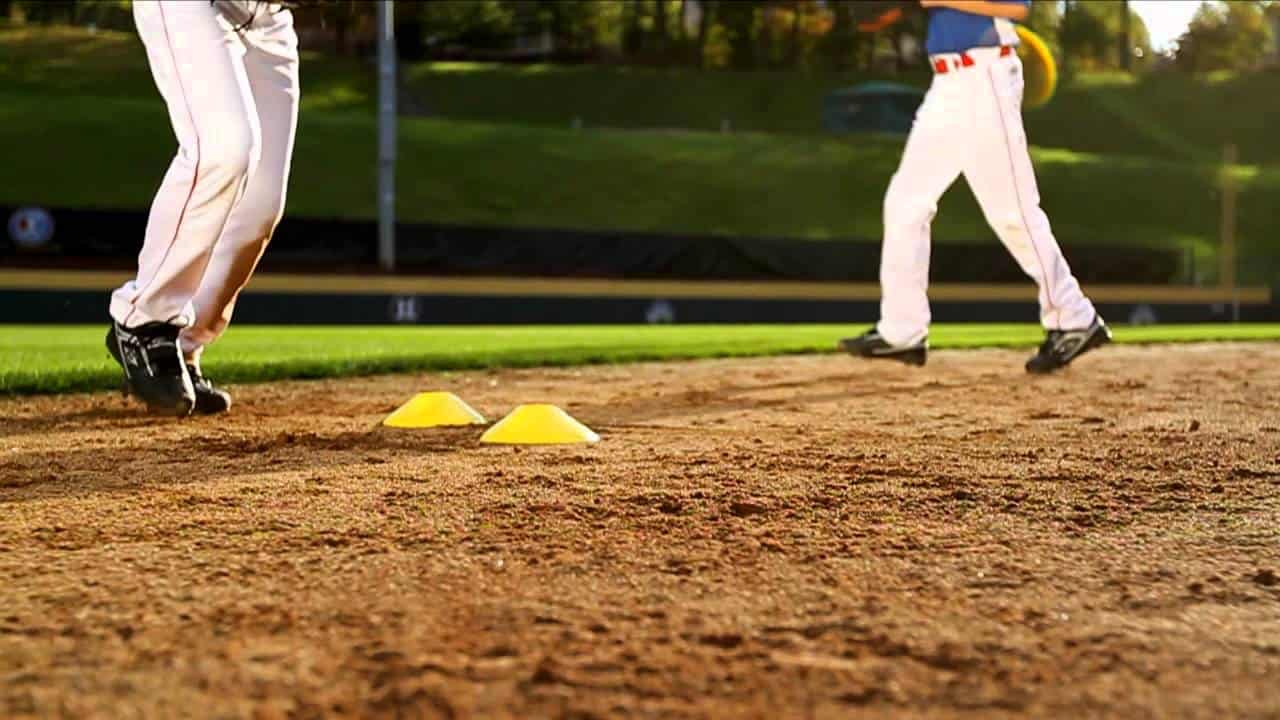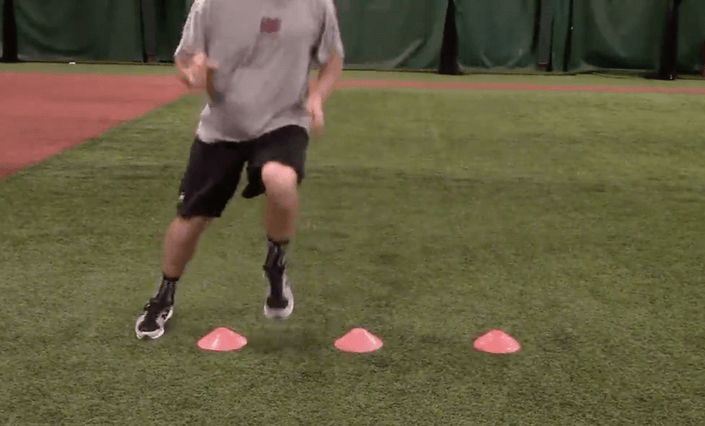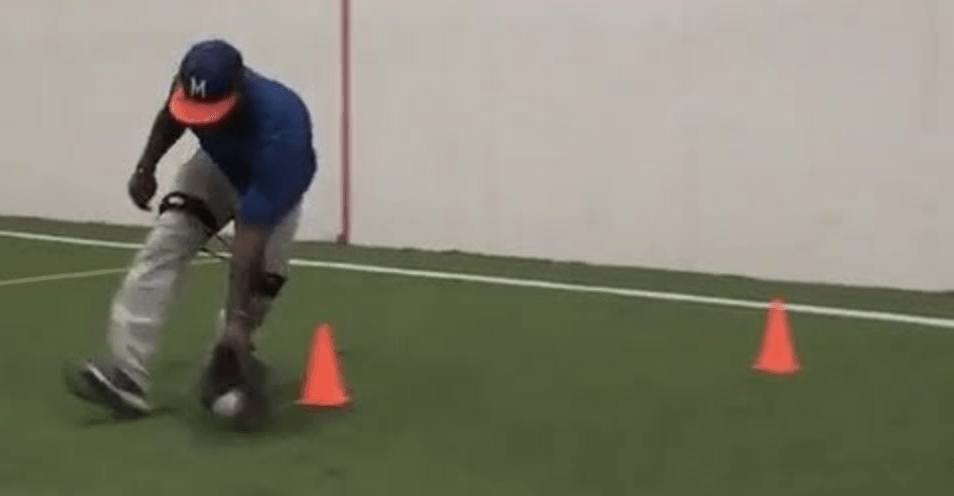Being agile means being able to move quickly and easily. Infield and outfield defensive ballplayers need to have agility, as well as the footwork to react fast and field ground balls that hops unpredictably, and outfielders who run back to catch fly balls behind their bodies. Batters also need agility drills for baseball to be able to run faster from home to first.
Agility drills improve players reflexes, reaction time, and physical strength. The more agile your players are, the higher their fielding and running performance.
Drills centered on throwing and catching ground balls and pop flies are important to develop fielding ability, but agility drills focus on the four basics of playing sports: agility, speed, quickness and footwork. These drills can be performed as part of an exercise regimen during baseball practice. But it’s encouraged for players to do these drills on their own as well.
Bunny Hops
This drill uses traffic cones like other fielding drills, but requires players to use more leg power than it takes to run fast around the bases. It’s recommended to have your players perform this no sooner than 30 minutes into practice.

The coach has 5 traffic cones at his disposal and lines up three of them in a straight line about 3-4 feet apart from each other. He instructs his players to line up in a row behind the first cone. Players stand with their feet together and prepare to jump over the cones.
The coach says, “Go” and the first player hops over the first traffic cone, then the second and the third, with enough space in between each cone to land and then hop again over the second cone.
Encourage your players to use their arms when they jump. Pumping arms helps them to jump higher. After they’ve successfully jumped over three cones, add a fourth one at an equal distance away and have your players jump over them again. Work up to jumping over five cones in all.
After the team has jumped over t five cones, have each player turn around and jump over them again in the opposite direction.
Side Hops
Unlike the previous exercise, for this cone drill, your team must jump the first cone and without stopping, jump over the next and the next in succession until they have jumped over all five cones. It’s a non-stop drill. 
After players have jumped over the five cones, encourage them to set up and jump over them again in the opposite direction. This drill is important for developing lateral quickness and power, and will loosen up you infielders, helping them to field ground balls hit to their left or right with greater ease.
As with the previous cone drill, players should pump their arms when hopping over the cones.
Agility Ladder Feet Shuffle Drill
All players need to have speed and be quick on defense running to catch a fly or field ground balls. Speed, agility, quickness and footwork are key to precise movement that every player must have, from pitchers to outfielders.
 Agility ladders have risen in popularity in the past few years and have become useful building players’ footwork abilities. I recommend picking one up on Amazon if you have the chance. They’re great tools.
Agility ladders have risen in popularity in the past few years and have become useful building players’ footwork abilities. I recommend picking one up on Amazon if you have the chance. They’re great tools.
For this drill, we recommend coaches obtain one of the agility ladders available at sporting goods stores or at places online. The cost is very low but will benefit your players’ workout regimen because of its simplicity and ease of use.
An agility ladder looks like a regular ladder but is made from nylon and plastic. The rungs are adjustable. An agility ladder 15 feet in length works well with this drill. Adjust the rungs wider apart for more advanced baseball agility drills.
Because agility ladders lay flat on the ground, step drills like this one can be performed with them instead of traffic cones. This drill is a shuffle drill and can be thought of as dance training, except for baseball players.
Lay the agility ladder on the ground, preferably outdoors on a flat surface like cut grass or infield dirt. Players stand on the left side of the agility ladder at one end.
- Step into the ladder with your right foot.
- Bring in your left foot. You now stand between the first two rungs of the agility ladder.
- Step out with your right foot.
- Left foot moves up to the next “box” between the next set of rungs.
- Bring your right foot in.
- Left foot out.
- Right foot in.
- Continue with this footwork pattern all the way up the ladder.
The idea is for players to shuffle through the agility ladder outside and between the rungs in this step pattern. Feet and legs go up, knees bend as your team increases their agility stepping through the drill.
When fielding grounders and moving to throw to infield bases, this shuffle pattern drill duplicates actual footwork players make in game play.
Running and Switching Drill
Infield and outfield players run backward when the ball is hit behind them but near enough to catch if they can run sideways and back while tracking the ball’s flight at the same time.
For this drill, the coach begins standing about 8 feet in front of one of his players, both of you facing each other. The coach says, “Go” and the player starts to creep forward, left foot first followed by right.
After taking two creeping steps forward, the player runs to his left quickly on his feet. Coach says, “switch” and the player runs back in the opposite direction and back, extending his glove while running. The coach throws him a fly ball to catch, the player tracks with his eyes and catches it.
The more repetitions of this drill (10-15), the more agile your players become in their running and switching movements. Players should always run light on their feet in the drill and track the ball while they run. Players have accomplished the drill’s purpose when they are able maintain eye contact with the ball while running.
Backpedal Ball Drop Drill
This drill should be done only after initial team warmups have been completed. It uses the hamstrings at the back of the legs and requires agility and coordination to perform, so make sure your players are physically ready after the initial workout.
 Team up players in pairs of two and have them line up along the first and third base sidelines. One player has the ball while the second player retrieves it.
Team up players in pairs of two and have them line up along the first and third base sidelines. One player has the ball while the second player retrieves it.
One player now backpedals along the foul line away from the player with the ball. The player with the ball holds the ball out at arm’s length away from him. At the moment the player backpedaling sees his teammate drop the ball, he reverses direction and runs forward to catch it.
The running player, having retrieved the ball, returns it to the stationary player and begins to backpedal again, repeating the sequence. After 10 repetitions of backpedaling and starting over, the player pair switches roles.
Quadrant Drill
Footwork is the key to an effective defense, and the more directions players can run, the easier it will be for them to field balls hit to their left, right, in front and behind them.
For this drill, use two long pieces of tape each about five feet long, one length of tape crossing the other directly in the middle, creating 4 zones of equal size labeled 1, 2, 3 and 4.
The coach directs each player to jump with feet together from one of the four zones to the next. Here are the different recommended jumping sequences:
- 1-4
- 1-2
- 1-3
- 2-4
Players should jump back and forth from one zone to the next, then back, and repeat 10 times, keeping their feet together. Once their jumping improves, instruct them to just through 3 zones, then 4.:
- 1-2-3
- 2-1-4
- 1-2-3-4
- 1-2-4-3
- 2-1-3-4
Once they’ve shown they can jump through four zones with ease, try jumping with one foot at a time. Make sure their posture is correct, chest up, face and neck forward. They should have their feet on the ground as little as possible.
Box Jumps
There has been a lot of promotion about the benefits of working out with a plyometric box. In reality, baseball coaches can use a simple box made out of wood. Dimensions of 28 inches by 24 inches by 20 inches is recommended. In this way, the height of the box can be adjusted upwards 4 inches at a time as their jumping improves. This drill will also help improve lateral  movement.
movement.
This drill should be performed without players wearing any excess padding or cleats. Have them remove their shoes. Place a box in the center of an area that has clearance of about 8 feet in every direction (4 feet on every side of the box). Have your players line up on one side of the box.
- Player squats about 8 inches away from the box, palms flat on the ground shoulder length apart.
- Coach says, “Go” and player jumps from his squat position up onto the box and lands on both feet.
- Jump back down off the box to their starting position.
- Repeat 10 times to complete one set.
There are several variations to this drill. After jumping up and off the box, players can start the drill on top of the box and jump off to the left, right or in front of them. Also, once they are conditioned to jump on and off the box, you can instruct your players to jump onto the box sideways up, sideways down.
5 Cone Ball Running Drill
This drill is specific to reaching to field ground balls and requires players to run forward, backward and side to side. Often infielders will have to pick up a baseball barehanded and then toss it quickly to another player to get a runner out.
Moving in all different directions with speed and agility is becoming more and more important in modern baseball. Once the foundation of quick movement with good footwork is established, then everything else players do, fielding, running and even hitting, get better because their feet move lightly and with quick precision.
For this agility drill, place five cones in a semicircle (half moon). The coach kneels on the outside of the cones and the player stands ready just outside one of the end cones and away.
The coach soft tosses a ground ball first to the cone nearest the player. Player scoops it up with his hand and tosses the ball underhanded back to the coach.
Next, the coach tosses to the next cone in the semicircle further from the player, who sprints to and fields it barehanded. Keep tossing until your player has sprinted to and fielded balls at every cone.
Players start slowing down with their back leg first, then the front leg. If their weight is forced to the front leg, they won’t be able to stop and will keep moving forward.
Delayed Steal Agility Drill
This is a running drill between bases. It emphasizes the shuffling motion runners take off the bag to take the secondary lead when on base. Making this drill part of your team’s practice regimen can help them get an extra base on a hit or a fielding error.
Place a runner on first base and instruct him to shuffle to the secondary base position off of the base. This is about two shuffles off first, left foot, right foot, then left, right again. Coach stands at home plate with a bat and baseball.
Coach hits the ball to shortstop. He will field it and toss to second to try to beat out your runner heading to second. The runner’s weight should be on his right foot at the moment the ball is hit. The second the ground ball is hit to shortstop, the runner moves and tries to beat the throw to the second base player covering the bag. Sliding is not necessary.
This drill could be done without a hit ball with fielders by placing runners at each base instead. The coach says, “Set” and each runner takes two shuffle steps off the bag and press on their right foot, waiting. Coach then says, “Go” and each player runs to the next bag.
A fun competition for the players is to turn the drill into a race to see who reaches the next bag 90 feet away, and make the competition a best of five.
Figure 8 Drill
The Figure 8 Drill is designed to improve strength in a player’s ankles and knees. It’s a simple drill that involves running around short traffic cones in a figure 8 pattern. Steering legs and feet around the cones improves knee and ankle strength.
You will need five traffic cones. Arrange the cones in a figure 8: two in a line about 5 feet apart, two more about 10 feet away parallel to the first two cones, and one in the center, making a figure 8.
- Player stands on the outside to the left of the cone. Coach says, “Go.”
- Player runs in a diagonal through the middle, passing on the right of the middle cone to the right outside cone.
- He continues, now running around the outside of the cones, entering the figure 8 again, this time passing on the left side of the middle cone and to the outside again.
- Player runs around the outer cones, back inside and passes the middle cone on the right.
Coaches should have a timer or stopwatch that usually comes installed in cell phones and ask players to run the figure 8 pattern for 2 minutes. Then stop and spread the cones further apart to increase the running and turning.
Push Up and Sprint Drill
This drill works all the muscles of the upper and lower body and only takes a few seconds to do. You can incorporate this drill with the figure 8 drill above. The more cone drills you add to it, the more workout your players experience.
This drill should be performed on a soft surface like field grass. If coaches have access to gym facilities, using a floor mat would also work, but a field with short cut grass will do. Players can wear sneakers or cleats.
 Player lays with his stomach on the ground, his palms pressed against the ground shoulder length apart, and his feet the same distance apart as his arms. The coach says “Go.”
Player lays with his stomach on the ground, his palms pressed against the ground shoulder length apart, and his feet the same distance apart as his arms. The coach says “Go.”
The player pushes off the ground to get to running position as quickly as possible, then sprints about 30 feet, all in one extended motion. You can include a figure 8 cone pattern at the end of their sprint for them to run around, then back.
Have your team push up and sprint one after the other, and keep the momentum going. The player who has completed the drill, can run in a circle back to the end of the line to push up and sprint again.
Running For a Double
This drill teaches players to stay light on their feet to run faster and to turn a single into a double when a ball is hit between two players on the opposition.
The coach lines up his players at home plate. This drill can be done without a baseball but you can also try simulating a real game by hitting a ball into the outfield with a fungo bat to see if your player can beat the throw to second.
Players assume the batting position, bat in hand. Coach says, “Go,” the player drops the ball and runs to first base. It’s important for the runner’s knees to pump high up, making sure to run on the balls of his feet from home to second.
Coaches can use their phone’s stopwatch to test players’ speed. You can make it a competition and clock the speed for the fastest runner.


